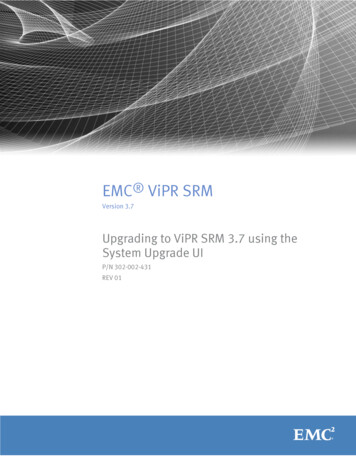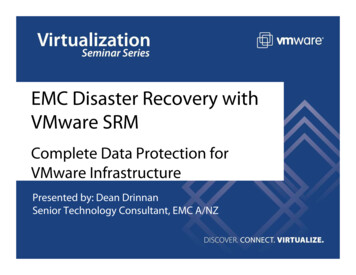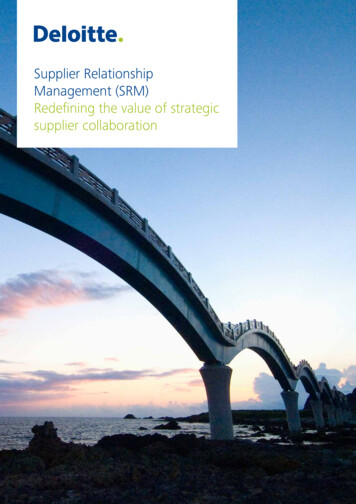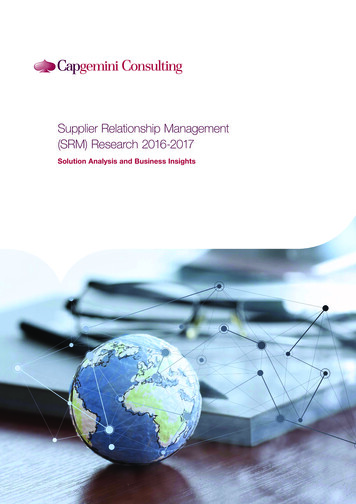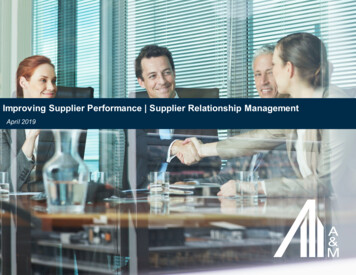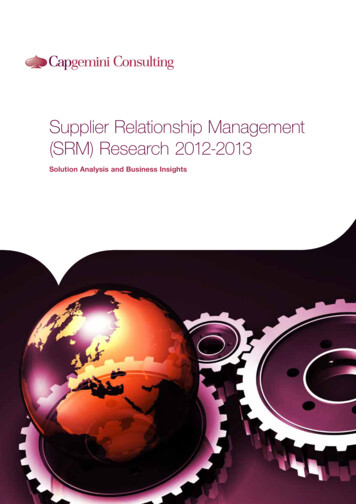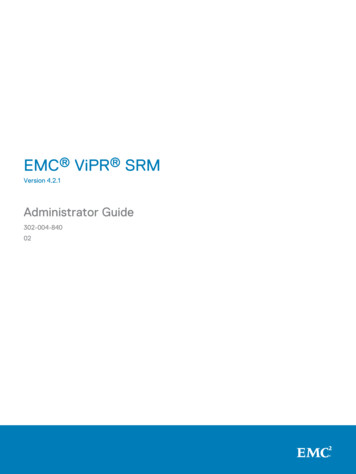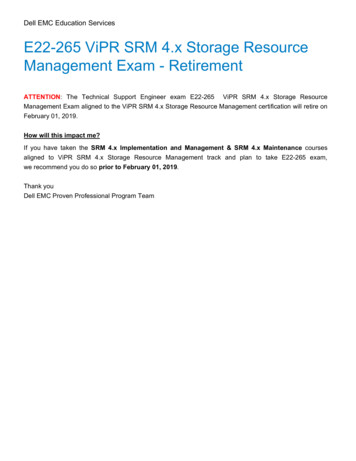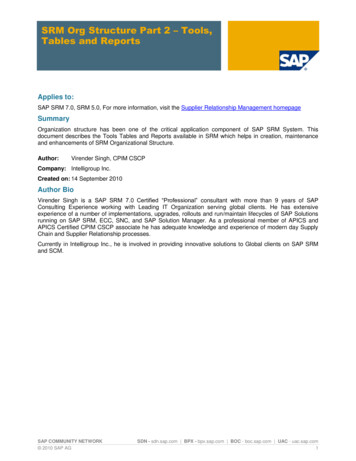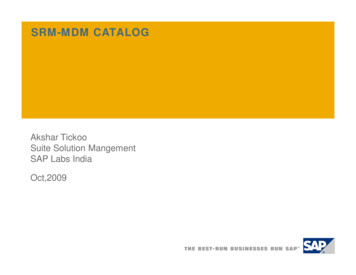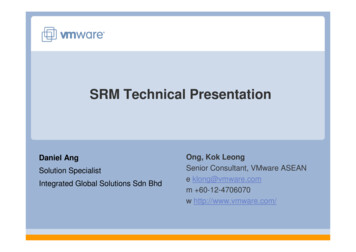
Transcription
SRM Technical PresentationDaniel AngSolution SpecialistIntegrated Global Solutions Sdn BhdV M W A R EF U L LS T A T U SOng, Kok LeongSenior Consultant, VMware ASEANe klong@vmware.comm 60-12-4706070w http://www.vmware.com/P A R T N E R
Agenda1. SRM Introduction and Concepts2. SRM 1.0 Prerequisites and SAN Integration3. SRM Workflows4. SRM Alarms and Site Status Monitoring5. SRM Core benefits and Summary6. SRM Demo
Advantages of Virtual Disaster RecoveryVirtual machines are portableVirtual hardware can be automatically configuredTest and failover can be automated (minimizes human error)The need for idle hardware is reducedCosts are lowered, and the quality of service is raised
Introducing Site Recovery Manager (SRM)Site Recovery Manager leveragesVMware Infrastructure to transform disaster recovery What it is:Site Recovery Manager is a new VMwareproduct for disaster recovery What it does:Simplifies and automatesdisaster recovery processesSetupTesting Failover Failback Site Recovery Manager works with VMware Infrastructure toenable faster, more reliable, affordable disaster recovery
Site Recovery Manager At A GlanceSite ASite BProtectedSiteVirtualCenterRecoverySiteSite RecoveryManagerVirtualCenterSite RecoveryManagerArray ReplicationDatastore GroupsDatastore Groups
Site Recovery Manager At A GlanceSite ASite BProtectedSiteVirtualCenterRecoverySiteSite RecoveryManagerVirtualCenterSite RecoveryManagerProtected VMs offlineProtected VMsonline in Protected SiteArray ReplicationDatastore GroupsDatastore Groups
Site Recovery Manager At A GlanceSite ASite BProtectedSiteVirtualCenterRecoverySiteSite RecoveryManagerVirtualCenterSite RecoveryManagerProtected VMsProtected VMsbecome unavailableArray ReplicationDatastore GroupsDatastore Groups
Site Recovery Manager At A GlanceSite AProtectedSiteVirtualCenterSite BRecoverySiteSite RecoveryManagerProtectedSiteSRM Supportsbi-directionalSite protectionRecoverySiteVirtualCenterSite RecoveryManagerProtected VMs powered onProtected VMsbecome unavailableArray ReplicationDatastore GroupsDatastore Groups
SRM Server Side Components *Site 1Site 2VC Server 1VC Server 2VCMS 1 DBVCMS 2 DBSRM Server 1SRM 1 DBSRM Server rArray 1Block Replication SWArray 2Block Replication SW* Note: Conceptual drawing only. SRM Server may run on another system than VCMSSRM 2 DB
SRM Concept Relationship “Cheat ible unit of storage thatcan be replicatedProtectedDatastoreContains one or more LUNs (i.e.VMFS)ProtectedDatastore Groups Auto-generated collection of oneor more datastores. Indivisibleunit or storage failover.ProtectedProtection Group Collection of all VMs stored in adatastore groupRecoveryRecovery PlanContains one or more protectiongroups
SRM Concepts And Their RelationshipsVMFS 1LUN 1Recovery Plan 1(Whole Site)Datastore Group 1Protection Group 1Protection Groups:Protection Group 1Protection Group 2VMFS 2LUN 2Protection Group 3LUN 3LUN 5Recovery Plan 2(Subset)Protection Groups:Protection Group 1VMFS 4LUN 4Protection Group 2VMFS 3Datastore Group 2Datastore Group 3Protection Group 3Protected SiteRecovery Site
SRM 1.0 PrerequisitesESX Server 3.0.2, ESX Server 3.5 or ESX Server 3iVirtualCenter (VC) server version 2.5 installed at the protected siteand at the recovery siteSRM server installed at the protected and at the recovery siteSRM plug-in installed on the VI Clients that will access the protectedand recovery siteNetwork configuration that allows TCP connectivity between VCservers and SRM serversAn Oracle or SQL Server database that uses ODBC for connectivityin the protected site and in the recovery siteA SRM license installed on the VC license server at the protectedsite and at the recovery sitePre-configured array-based replication between the protectedsite and the recovery site
Array Integration with SRM Vendor-specific scripts support:Storage PartnersArray discoveryReplicated LUN discoverySRM Test initiation (simulated failover in an isolated environment)SRM Failover initiation (actual failover of services to the recovery site) Array vendors will be responsible for creating the scripts fortheir Arrays to enable the integration with SRM
Safety Tip: DNS Validation – The Rule of ‘Four’ Validate DNS is working as expected and by performingthe following DNS lookups for the VC,SRM and ESXserversShort nameLong nameReverseForward
Safety Tip: DNS Validation – The Rule of ‘Four’ Validate DNS is working as expected and by performingthe following DNS lookups for the VC,SRM and ESXserversShort nameLong nameReverseForward
Safety Tip: DNS Validation – The Rule of ‘Four’ Validate DNS is working as expected and by performingthe following DNS lookups for the VC,SRM and ESXserversShort nameLong nameReverseForward
Safety Tip: DNS Validation – The Rule of ‘Four’ Validate DNS is working as expected and by performingthe following DNS lookups for the VC,SRM and ESXserversShort nameLong nameReverseForward
Safety Tip: DNS Validation – The Rule of ‘Four’ Validate DNS is working as expected and by performingthe following DNS lookups for the VC,SRM and ESXserversShort nameLong nameReverseForward
SRM Installation Workflow At the protected site the following activities are completed:Installation of the SRM serverInstallation of the SRM Plugin into the VI ClientInstallation of the Storage Replication Adapter (SRA) At the recovery site the following activities are completed:Installation of the SRM serverInstallation of the SRM Plugin into the VI Client *Installation of the Storage Replication Adapter (SRA) It is important to complete the SRM workflows in theorder detailed in this presentation* Note: Optional step, only required if a different instance of the VI Client is used to access the recovery site
SRM Setup Workflow – Protection Site At the protection site the following setup activities arecompleted:The user pairs the SRM servers at the protected and recovery sitesSecurity certificates are established between the SRM servers and theVC serversCertificates that are not properly signed willresult in the Yellow Warnings Signs.Reciprocity will still be established allowingyou to continue to the next step in theworkflow.
SRM Setup Workflow – Protection Site - continued Array ManagersConfigurationSelect the correct Manager Typefrom the Manager type dropdown boxNote: The SRM 1.0 Beta willonly support Manager Typesfrom EqualLogic andSymmetrix only
SRM Setup Workflow – Protection Site - continuedSRM identifiesavailable arrays andreplicated datastoresand determines thedatastore groups.
SRM Setup Workflow – Protection Site - continuedUsing the Inventory Preferences Mapper, the user maps resources inthe protected site to their counterparts in the recovery site.
SRM Setup Workflow – Protection Site - continued A protection group is a group of VMs that will be failed overtogether to the recovery siteWorking through the Protection Group wizard you will need to select alocation for temporary VirtualCenter Inventory files for the protectedVMs at the recovery site.
SRM Setup Workflow – Protection Site - continuedWorking through theProtection Groupwizard a userselects which VMsneed to be protectedand assigns them toa protection groupThe creation of aprotection groupresults in VCinventory updates inthe recovery site
SRM Setup Workflow – Recovery Site At the recovery site the following setup activity is completed:The user creates a recovery plan which is associated to a single ormultiple protection groups
SRM Recovery Plan
SRM Recovery Plan - continuedSRM Recovery Plans:turn manual BC/DR run books into an automated processspecify the steps of the recovery process in VirtualCenterProvide a way to test your BC/DR plan in an isolated environmentat the recovery site without impacting the protected VMs in theprotected site
Testing a SRM Recovery Plan SRM enables you to ‘Test’ a recovery plan by simulating a failover ofprotected VMs with zero downtime to the protected VMs in the protectedsite
Testing a SRM Recovery Plan - continued
Testing a SRM Recovery Plan - continued
Executing an actual failover in SRMWARNING - Executing an actual failover with SRM will permanently alter virtualmachines and infrastructure of both the protected and recovery sites
Executing an actual failover in SRM - continuedWARNING - Executing an actual failover with SRM will permanently alter virtual machinesand infrastructure of both the protected and recovery sitesWARNING – Failback to the protected site is a not an automated process in SRM 1.0
SRM Alarms and Site Status Monitoring SRM will support the following alarm notification actions:Send e-mail to specified addressSend SNMP trap to VC trap receiversExecute specified command on VC hostWe recommend you complete setup of alarm notifications for:Remote Site DownRemote Site Ping FailedReplication Group RemovedRecovery Plan DestroyedLicense Server Unreachable
SRM Alarms and Site Status Monitoring - continued SRM will raise VC events for the following conditions:Disk Space LowCPU use exceeded limitMemory lowRemote Site not respondingRemote Site heartbeat failedRecovery Plan Test started, ended, succeeded, failed, orcancelledVirtual Machine Recovery started, ended, succeeded, failed, orreports a warning
Site Recovery Manager Core Benefits Expand disaster recovery protectionNow any workload in a VM can be protected with minimal incrementaleffort and cost Reduce time to recoveryAs soon as disaster is declared, a single button kicks off recoverysequence for hundreds of VMs Increase reliability of recoveryReplication of system state ensures a VM has all it needs to startupHardware independence eliminates failures due to different hardwareEasier testing based off of actual failover sequence allows morefrequent and more realistic tests
Summary Site Recovery Manager Leverages VMwareInfrastructure to Make Disaster RecoveryRapidAutomate disaster recovery processEliminate complexities of traditional recoveryReliableEnsure proper execution of recovery planEnable easier, more frequent testsManageableCentrally manage recovery plansMake plans dynamic to match environmentAffordableUtilize recovery site infrastructureReduce management costs
Some Helpful Resources SRM Documentation http://www.vmware.com/support/pubs/srm pubs.htmlDR VMbook SRM Community srmSRA Documentation LinksLeftHand Networks SRA for VMware Site Recovery /VMware-LeftHand-SRA-DownloadHP disaster tolerant solutions using Continuous Access for HP StorageWorks Enterprise Virtual Array in aVMware Infrastructure 3 /4AA1-0820ENW.pdfVMware Site Recovery Manager in a NetApp 71.pdfDisaster Recovery Using Dell Equallogic Ps Series Storage And VMware Site Recovery ources/Tech ware-SRM.pdfImproving VMware Disaster Recovery with EMC RecoveryPointhttp://powerlink.emc.com/km/live1/en US/Offering Technical/Technical Documentation/H5582VMware Site Recovery Manager with EMC RecoverPoint Implementation Guide.pdfUsing EMC SRDF Adapter VMware Site Recovery Managerhttp://powerlink.emc.com/km/live1/en US/Offering Technical/White y-mgr-wp.pdfVMware Site Recovery Manager with EMC Celerra NS Series and Celerra Replicator Implementation Guidehttp://powerlink.emc.com/km/live1/en US/Offering Technical/Technical Documentation/H5581VMware Site Recovery Manager with EMC Celerra NS Series and Celerra Replicator ImplementationGuide.pdfVMware Site Recovery Manager with EMC CLARiiON CX3 and MirrorView Implementation Guidehttp://powerlink.emc.com/km/live1/en US/Offering Technical/Technical Documentation/H5583VMware Site Recovery Manager with EMC CLARiiON CX3 and MirrorViewS Implementation Guide.pdf
DEMODaniel AngSolution SpecialistIntegrated Global Solutions Sdn BhdV M W A R EF U L LS T A T U SP A R T N E R
SRM 1.0 Prerequisites ESX Server 3.0.2, ESX Server 3.5 or ESX Server 3i VirtualCenter (VC) server version 2.5 installed at the protected site and at the recovery site SRM server installed at the protected and at the recovery site SRM plug-in i
